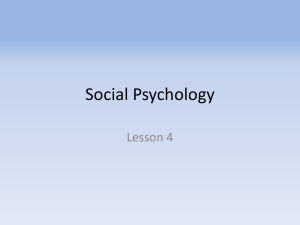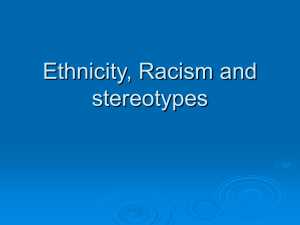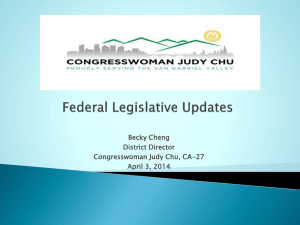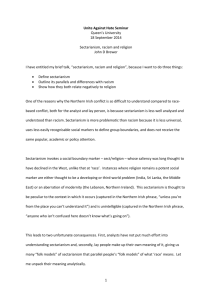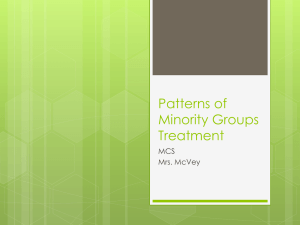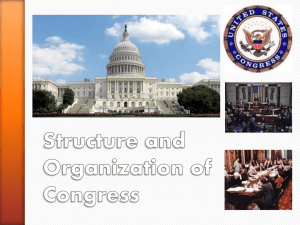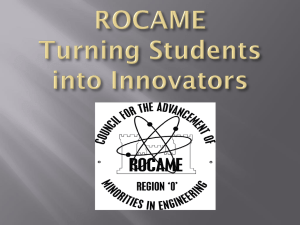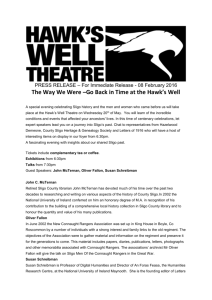Presentation of Phase I Evaluation to Peace Partnership
advertisement
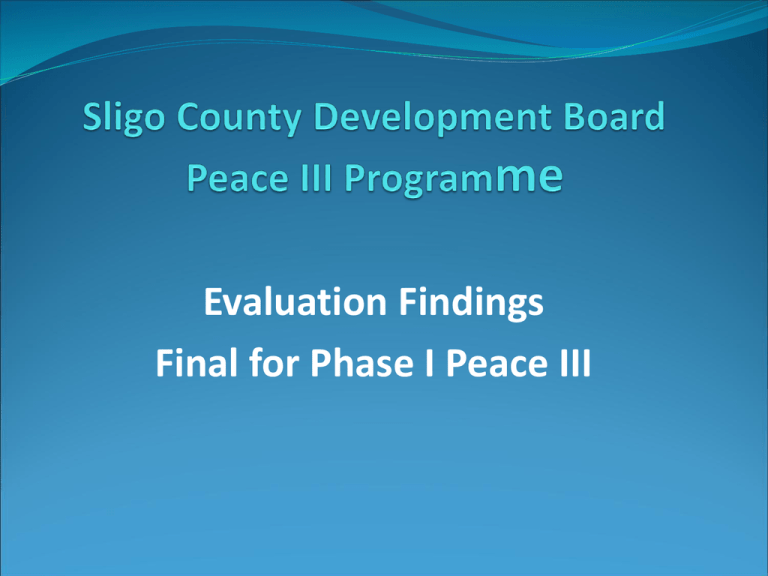
Evaluation Findings Final for Phase I Peace III Evaluation Methodology Formative Evaluation – overarching evaluation of all programmes together and ongoing throughout lifetime of the Co Sligo Peace III Action Plan – Phase I. External evaluators working with internal project evaluators - objectivity Using Aid for Peace Approach Framework – required by SEUPB and comprising the key elements of: Peace Building Needs Analysis – mapping the Conflict in Co Sligo (inc peace/conflict stakeholders) Conflict External Risk Assessment Peace and Conflict Effects Assessment Quantitative and qualitative measurement – quarterly progress reports and participants’ evaluation – through bespoke designed evaluation forms, focus groups and case studies – to give a 360º evaluation. Ongoing support to deliverers throughout their project delivery Purpose of Presentation Final Presentation of Findings from Phase I Strategic and programmatic issues – Learning Moving forward to Phase II – Recommendations Aid for Peace Approach Peace Building Needs Analysis - analysed the conflict dynamics and peace building processes in the county. Peace Building Relevance Assessment which considered how relevant the Peace Programme was to the peace building needs in Co Sligo. Conflict Risk Assessment - assessed the effects of the conflict on the peace building project actions being implemented by the various project action promoters. The Peace and Conflict Effects Assessment - examined the effects of the various project actions in having an impact on the conflict and peace situation in the county. The AfP Approach in Practice Stage 1 - meeting on a one-to-one basis with each of the project action leads and delivery partners Stage 2 - creating an overarching evaluation framework including data collection methods for all projects Stage 3 - facilitating an Aid for Peace workshop in the early stages of the programme with programme implementers and small grants Stage 4 - convening meetings (interim and final) of the Peace III Partnership to discuss the findings of the evaluation and take on board their issues, concerns, challenges and views on the overall project and its constituent project actions Findings – Key Achievements Baseline and Interim Stages – already described Final Stage – Key Achievements - outputs Participants have far exceeded the targets set – due to: recruitment efforts of project action promoters creative ways in which many project actions appealed to the communities not forcing people into peace building but rather taking the approach of where their interests lay Findings - Balances By age group - good overall balance at project level in terms of the various age groups By gender, overall women did outnumber men and whilst this would be expected in the women-focused project action, nonetheless in all of the programmes with the exception of the Travellers and Urban Peace building, women’s participation was greater. Men attracted to the practically-focused work – focus on good role models for young men Religious background – participation of minority Protestant community in line with population size. Cross Border – 29% participation from North Capacity Building for Peace Continuous emergence of new target groups –minority faith communities, victims of the Conflict, immigrants, young people, women Need for continued up-skilling, awareness raising and support for communities to address issues to do with understanding and taking action on sectarianism, racism and prejudice Need for ongoing training – e.g. Good Relations – to raise awareness of new contexts of peace building; up-skill people in current peace building practices; providing valuable networking opportunities for staff and volunteers, particularly if they are working in isolation. Accessing Target Groups Fear of engagement by some target groups (despite successive peace programmes) Designing and implementing programmes – need for sensitive approaches, need to take time to do this Accessing ethnic minority and minority faith groups difficulties which competition for groups’ participation ethnic minority groups are not so readily available minority faith communities - legacy of the past – polite silence difficulty in project actions recruiting from the displaced people/Republican community Enabling Understanding and Capacity to Engage – Sectarianism and Racism Tackling the silence how minority communities raise the issue; how the majority community acknowledges that it exists established steering groups to guide and support the work of the project action peace building is not a core priority and some groups are ‘switched off’ by the term Creative and innovative methods to challenge participants Building sectarianism and racism into the mainstream Addressing associated issues including anti-social behaviour Cross Border Issues Sometimes need for developmental phase - time- consuming and at times was a ‘stop-start’ process Requires careful logistical planning and good communication presented ongoing challenges: seeing the North as being ‘separate’ and with few common issues Need for definite cross-border partner and agreed/predetermined specific areas of co-operation Can be difficult to fund suitable partners, activities and a programme of work Visa restrictions (asylum seekers and certain work permits) Operational and Administration Issues Time taken to undertake particular activities - research, design and developmental phases of project actions Additional supports and requirements of the Phase I programme - Good Relations Training and the Aid for Peace Evaluation Framework Publicity - ensuring good attendance at events Administration of the project actions Sustaining Peace Building Creative in the engagement of communities Projects supported - not operating in isolation Projects to be enabled to see how they are contributing to a bigger and wider movement – e.g. billboard campaign - RAPID Urban Collective good relations training, mediation training aimed at project action promoters Civil society level - various peace building events weaved into specific public events Added Value of Project Enhanced the chances of peace building becoming a core part of community cohesion, integration and anti poverty work of council and its structures collective workshops - creating relationships local organisations - gained new skills and have considered embedding the concept of peace building into their mainstream activities. ongoing support through the support and workshop series initiative – sounding board for risks and difficulties Bringing out the hidden and hard to discuss issues and unlocking Added Value of Project cont’d unlocking of a more silent Protestant minority community expertise (sometimes external) and marry this with local knowledge thereby creating partnerships opening up of discussions around practical cross border actions time to heal wounds and rebuild relationships and create new relationships Capacity Building for Peace • Appropriate level of ‘capacity building’ is built into the terms of reference for the work – this gives credibility to the importance of the concept of capacity building for sustainable peace • Geared not only at local communities but also throughout the various sectors including private sector, elected representatives and statutory bodies Supports for Peace Building • Continue awareness, training and mentoring supports for peace building • Communicate the opportunities for people in regard of peace building supports to boost volunteering potential for peace building • More creative use of the Co Sligo Peace website Tools for Peace Building • Creative means - target groups which are fearful of; perhaps do not see peace building as relevant to; and those who are most difficult to reach • Build on what has been achieved in Phase I and reach back to those who accessed training - engaging their continued support for sustaining the peace building effort in the county • Provide accessible information on peace building • Peace website as a measure to provide support to communities Cross Border Collaboration At individual level- research and develop relationships with cross border partners before formal engagement; make sure they match the requirements of the project action Build on special relationship with the CAN (Carrickfergus, Antrim and Newtownabbey) Peace III Ensure that cross border partnerships are working to maximum effect - challenge themselves and their partners Networking and Communication Peace Partnership Committee and Secretariat provide networking opportunities to maximise opportunities for learning, sharing of practice and avoiding duplication/competition among project actions continue to spearhead role as peace building leaders in providing and stimulating debate on ‘hard’ issues embed the learning from peace building into the structures within the county Peace Project Promoters – collaborate to create progression opportunities for target groups and areas Leadership in Peace Building Highlight the learning from experiences (peace building sectarianism, racism and prejudice) with a view to embedding the issues at the heart of local governance and decision making Engage more fully with the decision-makers in the county - elected representatives to enable greater all round understanding of the relevance of peace building to the county Continuation of ‘challenge events’ which create wider public awareness Resources for Phase II Upload resources onto the Co Sligo Peace website and promote their use for future peace building work Build the use of these resources into the Terms of Reference for tenders in Phase II Operations for Peace Building Bring together all new deliverers of Phase II to learn from the experiences of Phase I Centralised recruitment process for the project - menu basis what is on offer and engage new people as well as Phase I participants Identify advocates from each of the previous programme to write a testimonial on the differences that the project made to them and their communities Discussion Response to Findings Any issues to be discussed?


